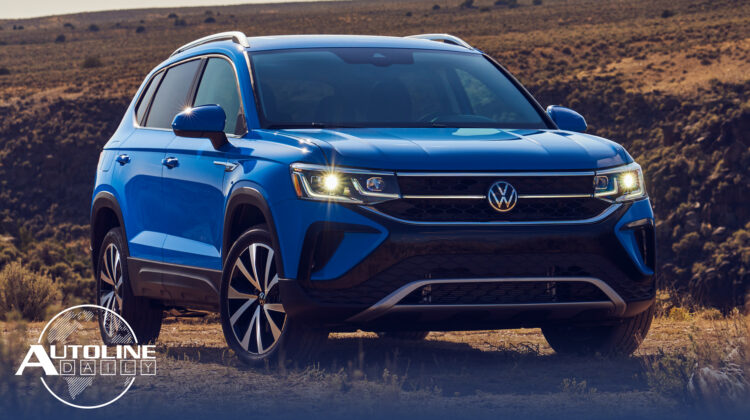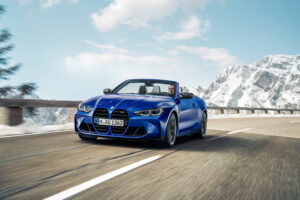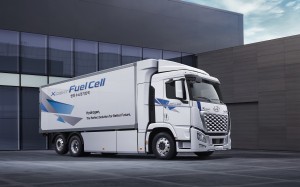
Listen to “AD #3088 – VW Taos Impressions; Tesla Removes Radar From Some Models; BMW Unveils New M4 Convertible” on Spreaker.
Follow us on social media:
Runtime: 9:42
0:08 BMW & VW Face Fines Over Collusion
0:56 VW Offered $9 Billion For Lamborghini
1:29 Tesla Removes Radar from Model 3s And Ys Produced in The U.S.
3:08 BMW Introduces New M4 Competition Convertible
4:21 Hyundai Improves Fuel Cell System in XCIENT Truck
5:10 Why the IONIQ 5 Won’t Have a Hyundai Logo on Its Steering Wheel
6:44 All-New Taos Feels & Drives Like a Volkswagen
Visit our sponsors to thank them for their support of Autoline Daily: Bridgestone, Intrepid Control Systems, Magna and Schaeffler.
This is Autoline Daily, the show dedicated to enthusiasts of the global automotive industry.
BMW & VW FACE FINES OVER COLLUSION
Back in 2019, the European Commission charged BMW, Volkswagen and Daimler with colluding to block the implementation of clean diesel technology. The companies were accused of restricting the size of urea tanks, which is a liquid that reduces nitrogen oxides emitted from diesels. The European Commission will soon hand out fines to BMW and VW however reports say it will be lower than anticipated. BMW originally set aside 1.4 billion euros to pay for the fine, but expects to add a billion euros to its earnings in the second quarter, which suggests its fine would be around 400,000 euros. Daimler doesn’t face a fine because it alerted authorities to the collusion.
VW OFFERED $9 BILLION FOR LAMBORGHINI
And sticking with Europe for the moment, the Volkswagen Group received a $9.2 billion offer from Quantum Group, a Swiss based investment consortium, to purchase Lamborghini. As part of the deal, Quantum Group is also proposing a strategic partnership with VW that would include a 5-year supplier agreement with Audi, which officially controls Lamborghini. But VW isn’t interested in giving up the Italian sports car maker and said thanks but no thanks to the offer.
TESLA REMOVES RADAR FROM MODEL 3s AND Ys PRODUCED IN THE U.S.
Tesla is taking its first steps towards implementing its camera-only vision system for its automated driving technology. Yesterday, the EV maker announced it will no longer install radar in Model 3 and Ys produced in the U.S. Called “Tesla Vision,” the system relies on cameras and neural net processing to enable Autopilot, Full-Self Driving and other safety systems. But some features will be limited initially without the radar. Autosteer won’t work above speeds of 75 MPH and requires a longer minimum following distance. Also, Smart Summon and Emergency Lane Departure Avoidance may be disabled at delivery. But the company will restore those features with over-the-air updates. Tesla plans to remove radar from its other models and models built outside of the U.S. but it did not share a timeframe as to when it will happen.
BMW INTRODUCES NEW M4 COMPETITION CONVERTIBLE
We’re not a big fan of its looks, but would have no problem sliding behind the wheel of the new BMW M4 Competition Convertible. That’s because it would be wicked fun to drive. It’s powered by a twin turbo inline 6-cylinder engine that makes 510 horsepower. Paired to an 8-speed auto trans and AWD, this softtop can do 0-100 km/h in just 3.7 seconds. Speaking of the softtop, it’s a new design that mixes elements of a retractable hardtop and a traditional fabric top, but is still 40% lighter than the old top. And all the light that it lets in will give owners a nice view of the M specific displays and controls as well as premium leather materials and sport seats. Owners are going to need those seats to keep their butt inside the car. Not only did BMW specially tune the suspension and steering, it improved the brakes, added performance adaptive dampers as well as a number of braces and struts to improve body stiffness. The M4 Competition Convertible starts hitting dealers this July.
HYUNDAI IMPROVES FUEL CELL SYSTEM IN XCIENT TRUCK
Hyundai improved its fuel cell system that goes into the new XCIENT truck, which starts production in August. It features two 90-kW fuel cell stacks that are fed by seven hydrogen tanks, which combine for 31 kilograms of storage. Three 72-kWh battery packs provide an additional source of power. But it’s all fed into a 350-kW electric motor that drives the wheels. Hyundai estimates the truck will be able to travel up to 400 kilometers or roughly 250 miles. Right now, the XCIENT is only sold in Switzerland, but it plans to expand to other European markets, so it can reach its goal of selling 1,600 fuel cell trucks by 2025.
WHY THE IONIQ 5 DOESN’T HAVE A LOGO ON ITS STEERING WHEEL
Viewer Luke Rinderknecht has a great eye. He commented yesterday, “I’ve noticed no logo on the steering wheel for the IONIQ in a number of videos. I wonder what will be there for the production version; will it really be blank? Or perhaps an as-of-yet unreleased logo specific to the sub-brand?” So, we reached out to Hyundai for an answer. And the answer is… no logo. It says the logo-less steering wheel fits the interior theme, which is minimalistic, meant to remind you of home furniture rather than a typical auto interior. And now that we’ve got the answer, let us know what you think.
ALL-NEW TAOS FEELS & DRIVES LIKE A VOLKSWAGEN
Volkswagen was late to the party coming out with crossovers, but it’s finally getting there. The new Taos joins the Atlas and Tiguan and rounds out the bottom end of Volkswagen’s ICE CUV lineup. Its job is to wrestle customers away from the likes of the Subaru Crosstrek, Kia Seltos and Jeep Compass. The Taos sits on VW’s MQB architecture and is powered by a 2-liter turbo that makes 158 horsepower and 184 pound feet of torque. Base price for the front wheel drive version is $24,000 including destination charges, while the all-wheel-drive version starts $1,000 above that. A fully-loaded version will go for about $34,000. We got to spend time in both the front drive and all-wheel-drive versions and it definitely feels and drives like a Volkswagen. The whole package feels rock solid. The steering is precise and responsive. The brakes are easy to modulate. Acceleration is good off the line, but a bit wheezy in passing maneuvers if you’re already rolling at, around, 50 miles an hour. Not surprisingly the all-wheel-drive version has more resonance running through the structure, and has a harsher ride—thanks to higher spring rates needed for the extra weight of the axles and differential. Inside, the Taos offers the kind of UX and electronic safety systems that every automaker needs to have in its cars these days. An 8-inch touch screen is within easy reach on the center of the dash and the electronic instrument cluster is crisp and easy to read. There is ample luggage space in back and the rear seat is surprisingly roomy, with decent headroom and thigh support. In a way, you can think of the Taos as the replacement for the Golf. This is probably going to become VW’s best-selling vehicle in the U.S. market. And this may be just the beginning. VW is looking at a possible GTI variant of the Taos and maybe one with more off-road capabilities.
This is a big year for Jeep, and we’ve got Mark Allen, the head of Jeep design coming on Autoline After Hours tomorrow afternoon. So join John and Gary for insights into where Jeep is going with its future designs.
But that wraps up today’s show, thanks for watching.
Thanks to our partner for embedding Autoline Daily on its website: WardsAuto.com
Seamus and Sean McElroy cover the latest news in the automotive industry for Autoline Daily.










